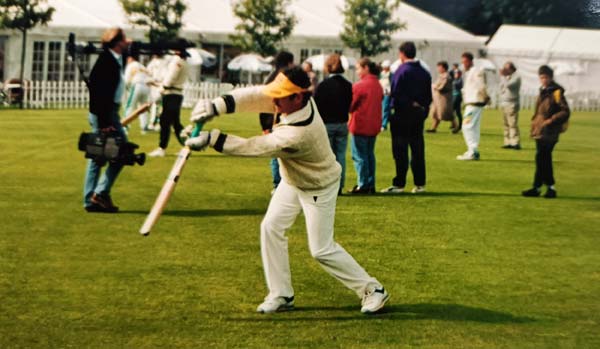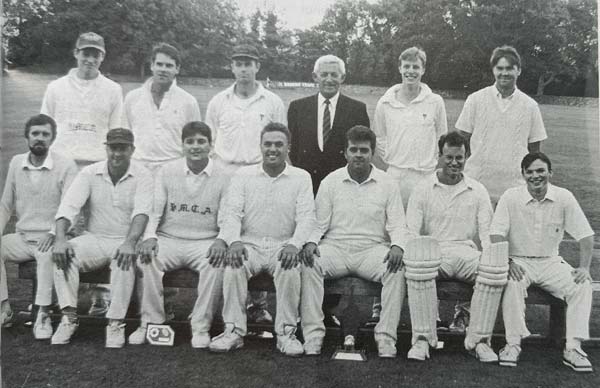1993
Before the 1993 season began, cricket in Leinster was struck a blow with the death of Sean Pender. As cricket correspondent for The Irish Times, Sean's columns were the source of pretty much all cricket information available on Leinster cricket.
On Saturday mornings there was a preview of the weekend's action along with team listings. On Mondays, a review of the games perhaps with a match report, full score cards or match highlights and then on Tuesday his opinion piece was always a good read.
Sean provided a huge amount of coverage for a minor sport in a national paper and to be perfectly honest we probably took it for granted. He had joined the paper in 1964 as a sub editor and League of Ireland football was his other great interest. He had played cricket for Merrion and as a journalist was always fair and balanced. Leinster cricket owed him a huge amount.
In his place came Peter O'Reilly who had written for the Sunday Tribune and Sean's right hand man Tom Devlin took a greater role in reporting games since Peter was still very much a player. The coverage provided for cricket in the Leinster region by Sean (and of course Ger Siggins at the Sunday Tribune) was disproportionate to the reach of the game and a huge debt owed to these journalists for their persistence in finding space for local cricket in the national papers.
It was a neat little coincidence that as I started writing this review that the youngest got word that he had been awarded the Sean Pender Award for Fair Play from the Leinster Cricket Umpires and Scorers Association for 2023, 30 years after his death. It is fitting that given his contribution to Leinster cricket that his name still lives on.
After Clontarf’s successes in 1992, 93 proved a bit tougher for the new captain Alan McClean. It was the first year of a new league format and while we succeeded in maintaining our place in the higher division, we did not threaten the title, being very much the draw specialists.
But if the point of the new structure was to provide a competitive league, then it has to be seen as a success. Only 74 points separated the top side from the 5th place. Poor Mighty had a hard time putting out consistent sides.
There were a number of reasons for this. A senior player insisted on playing rugby into the early cricket season, lost to St. Mary's in the Cup Final, thanks for asking again, on the plus side, that same senior player decided to end his rugby career at that point. It was still possible back then to be a dual sportsperson, something that seems to be out of fashion these days.
Perhaps I’m wrong, but sports (not just cricket) seem to put undue pressure on players to focus their efforts on one (their) sport. The age profile of the side had shifted significantly from being “experienced” to “youthful”.
The early season saw no sign of Gerry Kirwan. Gerry had in fact retired at the end of the 92 season and in doing so fulfilled the prophecy made by Peter O’Reilly in his Sunday Tribune report of the cup final of that year. It was very much in keeping with the type of man that Gerry is that he opted to retire with the minimum of fuss, telling only those closest to him and avoiding any attention being drawn on him.
Clontarf found it difficult to cope with the loss of a bowler like Kirwan, in reality it would take 2 bowlers of comparable standard and they unfortunately did not grow on trees. Through the connections of John Lyon, a young South African left arm seamer arrived for the summer. The wonderfully named LeBeau Jonker had a good year but the attack lacked bite which meant draws were the order of the day for us.
The other new arrival in Castle Avenue was the laying of an artificial wicket on the square. The club had not been particularly supportive of this equipment and I think that this was purely seen as a training option, in truth they weren't quite sure of what to do with it.. Of course, nowadays, every square has an artificial and where would the game be if it wasn't for them?
At the end of the league programme, Leinster were destined to drop into Section 2 for 1994 to be replaced by Carlisle. In Section 1, it was as close as it could possibly be. YMCA and Pembroke had identical records of Won 5, drew 5, lost 2, so the final result depended purely on bonus points which left YMCA as the winning side.
Captained by Keith Bailey, it was an excellent year for YM who found their mojo again during the season. Keith was in his second stint as captain having led the club in 1988. An excellent wicket keeper he was an ideal man to handle the exuberant talents at his disposal. Known throughout cricket circles as Bails, his ability was obvious from his time as a schoolboy in Wesley College. He was also a very good batsman which was his original role on YM’s first team before he took over the gloves from Frank Sowman.
As his career progressed his keeping was the primary focus and perhaps his batting slipped a little mainly it has to be said due to the powerful line up in his club’s top order. His keeping though was superb, well known for his ability in standing up and 50% of his games were on the unreliable Claremont Road.
He was unlucky that his international career coincided with the peerless Paul Jackson and was limited to 11 caps. In 1993 he still had a top class batting line up to call on, Alan Lewis and Mark Nulty had good seasons but the star of the batting show was Angus Dunlop who passed 1000 runs in Leinster in winning the Marchant Cup, he also added the all rounders award. The only blot on Gus’ season was a tough day when Ireland took on Australia in Castle Avenue and Allan Border took a liking to his bowling.

Allan Border prepares for the game against Ireland
YM were pushed hard by a developing Pembroke side, who had some up and coming players mixed in with the experienced competitors. While they must have been disappointed to miss out in the league they made up for it in their Cup run.
A run which involved beating Dublin Uni and Malahide before a victory over Phoenix in the semi meant that they would face Old Belvedere in the final on their home ground. In their journey to the final OB beat Merrion, CYM and Clontarf and it was a team that had experienced a turnover in staff.
With no McGraths playing their new bowling attack was led by the young speedster, Owen Butler. However, it did not go to plan for Belvo after Peter O’Reilly won the toss and batted. Losing early wickets was not in the game plan.
Paul O’Riordan led the fight back, a beautiful striker of the Paul fell to a brilliant catch behind the wicket by “Charlie” Kavanagh. Only now I realise just how many excellent keepers there were in my years in Leinster cricket. Think of Fergus Carroll, Bails, Gerry Murphy, Charlie, Anto Canavan, Trevor Tully, Mick Dwyer, Fintan Kelleher, literally I could name the keeper of every team and he would be top class.
Wickets of that era were so low that the skill in keeping was measured by the ability to stand up and all of these players were excellent in that role. Charlie’s catch in this game meant that Belvo’s best chance of a decent score disappeared with Paul’s dismissal. A final score of 133 in front of a big partisan crowd was always going to be difficult to defend and sure enough Pembroke put their heads down and comfortably reached their total losing just 2 wickets on the way, allowing Ronan Malin to lift the trophy.
YM were back in business in the Wiggins Teape league reaching the final after beating Clontarf by just 1 run in their semi final while Carlisle were victors over Malahide by a more comfortable 5 wickets. The final however saw a dominant performance by the Sandymount side and a straightforward 9 wicket victory.
Carlisle’s total of 182 for 7 was a good effort after their star batsmen Marc Cohen and Jason Molins were back in the pavilion with only 14 on the board. Stephen Molins and Leon Ellison both got into the 30s while Tom O’Neill back in Malahide after moving across the river top scored with 41 not out and he and Nick Riches helped get a score for their team. Nick’s son Callum would, of course, play with great distinction for Malahide in recent years. The total however was not nearly enough as Gus Dunlop and Alan Lewis put together an unbeaten partnership of 160 to ensure both league titles went to YMCA.
However, that was not the final tally for YM, they also went and won the Alan Murray Cup (20 overs) beating Old Belvedere in the final. A treble for Bails, not bad at all.

YM’s treble team




